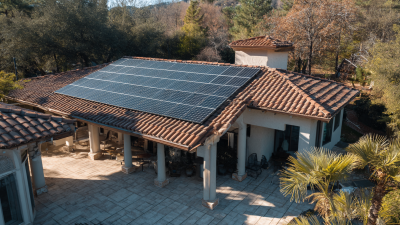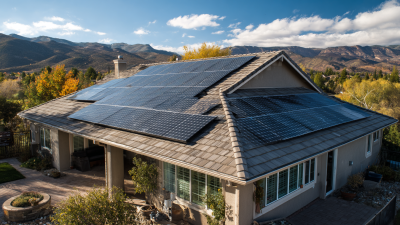Harnessing the Power of Home with Residential Wind Turbines for Sustainable Living
In recent years, the pursuit of sustainable living has gained momentum, with a notable focus on renewable energy solutions. According to the Global Wind Energy Council, the global installed capacity of wind energy reached over 743 GW by the end of 2020, highlighting a shift towards cleaner energy sources.

Understanding Residential Wind Turbines: Benefits for Sustainable Living
 Residential wind turbines are becoming increasingly popular as a sustainable energy solution for homeowners, especially in areas like Kansas, where the state ranks fourth in the nation for wind capacity. These turbines harness the natural wind flow to generate electricity, offering numerous benefits for sustainable living. One of the key advantages is the significant reduction in dependence on fossil fuels, which not only helps lower greenhouse gas emissions but also contributes to cleaner air and improved public health.
Residential wind turbines are becoming increasingly popular as a sustainable energy solution for homeowners, especially in areas like Kansas, where the state ranks fourth in the nation for wind capacity. These turbines harness the natural wind flow to generate electricity, offering numerous benefits for sustainable living. One of the key advantages is the significant reduction in dependence on fossil fuels, which not only helps lower greenhouse gas emissions but also contributes to cleaner air and improved public health.
Additionally, incorporating wind energy at home can lead to substantial cost savings on energy bills. According to recent industry reports, homeowners can save between 30% to 50% on energy costs by using residential wind turbines, significantly offsetting installation costs over time. Moreover, utilizing renewable energy sources like wind adds value to properties as more buyers prioritize sustainability in their purchasing decisions.
Tips: Consider local wind conditions before installation; places with average wind speeds of 10 mph or more are ideal. Regular maintenance is crucial for maximizing efficiency—make sure to check the turbine regularly for any signs of wear or damage. Lastly, explore local incentives or rebates for renewable energy installations, as these can significantly reduce upfront costs.
Choosing the Right Wind Turbine for Your Home: Key Factors to Consider
When considering the integration of residential wind turbines into your home, several key factors are essential to ensure a successful and efficient setup. Firstly, the site’s wind resource is paramount. Conducting a wind assessment through local meteorological data or installing a temporary anemometer can provide critical insights. Ideal locations typically sustain an average wind speed of at least 10 miles per hour. Additionally, prospective homeowners should evaluate the physical environment, including any potential obstructions like trees or buildings, which can impact wind flow and the overall effectiveness of the turbine.
Another crucial consideration involves turbine specifications and size. Residential turbines come in various types and power outputs, typically ranging from 400 watts to 10 kilowatts. For homeowners, understanding energy needs and consumption patterns is vital when choosing a turbine. Also, it's important to check local zoning laws and regulations regarding height restrictions and noise levels to ensure compliance. Ultimately, selecting the right wind turbine involves a blend of technical assessment, proper planning, and community engagement, paving the way for sustainable living solutions that harness the power of wind effectively.
Installation Guide: Setting Up Your Residential Wind Turbine Safely
When considering the installation of a residential wind turbine, safety should be your top priority. Begin by assessing your property to identify suitable locations for the turbine installation. Ideally, the site should be clear of obstructions such as trees and buildings that could block wind flow. It's essential to check local regulations and zoning laws, as some areas may have restrictions on turbine height or placement.

Once you have determined a suitable site, ensure you have the necessary permits and approvals before proceeding. Choose a turbine that is appropriate for your wind conditions; consult with manufacturers or local experts to find a model that fits your needs. During installation, follow the manufacturer’s guidelines closely, utilizing safety gear. Pay special attention to securing the turbine’s base and ensuring that it is properly anchored to withstand strong winds.
Lastly, consider conducting a post-installation inspection to confirm that all components are functioning correctly and that the turbine is securely installed, allowing you to enjoy sustainable energy safely.
Maximizing Efficiency: Tips for Optimal Wind Energy Production
To maximize efficiency in residential wind energy production, it's crucial to carefully select the appropriate turbine size and type based on local wind conditions. Understanding the average wind speed in your area will help you determine the optimal turbine specifications. Smaller turbines work well in low-wind areas, while larger models are suitable for locations with stronger, more consistent wind patterns. Additionally, a professional wind site assessment can provide valuable insights, ensuring the chosen equipment aligns with both the environment and energy needs.
Another essential factor is the turbine's placement. Positioning the wind turbine at an elevated point, away from obstructions like trees and buildings, significantly enhances wind capture. Furthermore, maintaining a clear area around the turbine minimizes turbulence and optimizes airflow. Regular maintenance checks are vital to ensure all components are functioning efficiently, as wear and tear can reduce energy output. By focusing on these strategies, homeowners can effectively harness wind energy, contributing to sustainable living while maximizing their investment in renewable resources.
Monthly Wind Energy Production from Residential Wind Turbines (kWh)
Maintenance Essentials: Keeping Your Wind Turbine Running Smoothly
Maintaining a residential wind turbine is vital for ensuring its efficiency and longevity. Regular inspections are key to detecting any wear or damage. Homeowners should dedicate time each season to examine the turbine blades, gearbox, and electrical components. This proactive approach helps catch potential issues before they escalate, saving both time and money.
In addition to inspections, routine cleaning is important for optimal performance. Dust, debris, and bird droppings can accumulate on blades, reducing their efficiency. A simple wash with water and a gentle brush can significantly enhance energy output. Furthermore, checking the turbine's lubrication and ensuring that all moving parts are adequately greased helps to prevent friction and prolongs the life of the system. By incorporating these maintenance essentials, homeowners can maximize the benefits of their wind turbines and contribute to a sustainable living environment.
Harnessing the Power of Home with Residential Wind Turbines for Sustainable Living - Maintenance Essentials: Keeping Your Wind Turbine Running Smoothly
| Maintenance Activity | Frequency | Estimated Time (Hours) | Tools Required | Notes |
|---|---|---|---|---|
| Inspect Turbine Blades | Monthly | 1 | Binoculars, Ladder | Look for cracks or wear |
| Lubricate Bearings | Quarterly | 2 | Grease Gun, Oil | Ensure proper lubrication |
| Check Electrical Connections | Bi-Annually | 1.5 | Multimeter, Screwdriver | Fix any loose connections |
| Clean Turbine Components | Annually | 3 | Rags, Cleaning Agents | Remove dirt and debris |
| Test Wind Turbine Performance | Annually | 2 | Tachometer, Software | Evaluate efficiency and output |
Related Posts
-

Advantages of Using Best Residential Wind Turbines for Sustainable Living
-

The Ultimate Checklist for Selecting the Best Residential Wind Turbine for Your Needs
-

How to Maximize Efficiency with Solar Hybrid Solutions for Global Markets
-

How to Maximize Energy Savings with a Home Solar Power System
-

The Future of Clean Energy Exploring Innovative Wind Turbines
-

5 Essential Tips for Maximizing Your Solar Power System Efficiency
